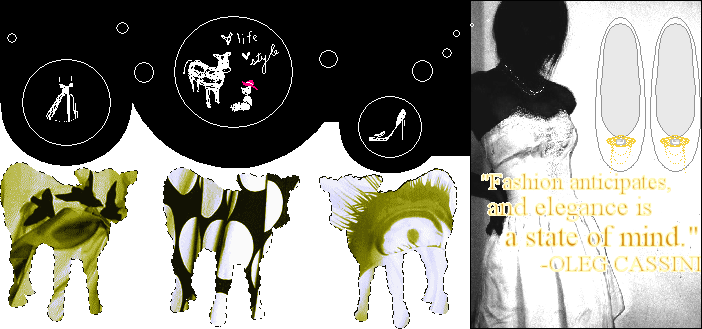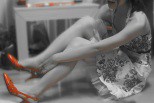Not your Grandma's Kinda Jewelry
Through the magic powers of Etsy, I have found the epitome of jewelers with a fresh and personalized take on jewelry in Bethany Cooper (and affordable for us normal folks).
I actually came upon her designs last year at about this time. I fell in love with this necklace:

However, of course, the leather cord and carved bone bunny couldn't really float with me. I knew she did some custom work-- she makes pendants as well as jewelry pieces-- so I asked her if she could make me a piece similar to that, but with certain adjustments (the materials used, a lighter wood, etc.). She completely understood and told me "I haven't managed to kick my animal products habit yet, so I really admire people who have."
So I got to thinking about how I would really like a custom jewelry piece for my 18th birthday and contacted her again to see if she happened to have those beads in stock again. She showed me two options-- I should have gone with the other option since it seems that those were more 3-D rather than flat-- but alas, there are negative aspects of the internet sometimes and you can't really see what something really looks like until it's right in front of you. But that's just a risk you have to take.
We had more correspondance and deliberation-- and me giving input at times-- almost annoyingly ;)-- she had orginally put a few freshwater pearls but I asked if she could replace them with another option because I felt like I would feel a bit uncomfortable. Why? (explanation from www.askcarla.com)
A pearl is an ulcer that is formed when an irritant, such as a parasite, enters an oyster, who responds by coating it with nacre (a crystalline substance that gives pearls their luster). Stress is what prompts an oyster to secrete nacre (just like stress creates human ulcers).
Because pearls naturally form in only one in 10,000 oysters and because the creation of a pearl can take up to three years, pearl-makers have devised a process called "culturing," or cultivating, that allows them to exploit oysters faster and cheaper.
Culturing involves surgically opening each oyster shell and inserting an irritant in the oyster. Freshwater pearls are cultured by inserting another oyster’s mantle tissue. Saltwater pearls have beads and another oyster’s mollusk tissue inserted. Fewer than half of the oysters may survive this process.
Cultivators further stress the oysters by suspending them in water in a cage, washing their shells, moving them around in different waters, and raising and lowering their cages to subject them to changing water temperatures.
After the pearls are extracted from the oysters, one-third of oysters are "recycled" and put through the culturing process again. The others are killed and discarded.
For those concerned about the environment, there is another reason to avoid pearls. Aquaculture has contributed to destruction of natural pearl oyster beds from pollution and overharvesting.
She said she didn't know of how exactly pearls are obtained but then again, not many people do seem to know of that. After all, they are living creatures.
Anyhow, the end product was this:

Yes, pretty different from the original, and in person, but still, amazingly handcrafted and a gorgeous piece in itself.

There's just something about custom jewelry in general and especially Bethany Cooper's fresh interpretation of jewelry. I think that's the best gift you could give to someone you love, a personalized (not just inscribed) piece that you had an active say in making. It's very reassuring to have a piece that's not mass-marketed and is individual to yourself and personality.
She was kind and wonderful enough to let me feature her on here :)
An Interview:
G: When/How did you get started jewelry-making? What made you start in this specific crafty-arena?
B: I have always been divided between music and arts and crafts. Growing up I studied painting and drawing; then at Hampshire College and at the University of Illinois, I got degrees in music composition and theory. While I studied music, I occasionally had periods of craftiness --collage books, sewing, a long period of making puppets (I liked the miniature aspect of them-- that foreshadows the beading obsession!).
When I finally got my doctorate, I needed a break from the academic music world (women are unfortunately still a rarity there). I realized I no longer wanted that career, a hard thing to accept after all that time; I felt pretty lost.
One day just a couple of years ago I felt bored and wanted to do something creative, but all the art equipment was set up in our cold, awful basement. My husband said, "Isn't there something small you could bring upstairs to work on?" I remembered this box of beads I had been collecting since I was a kid, and decided to grab it and play--and within days, I was totally hooked on making jewelry (and my bead collection started to grow to the massive size it is today)!
I think many people who make jewelry eventually wish they could make their own components and beads so they could have more control over the design; that's what led me to working with polymer clay, then precious metal clay, and fusing glass pendants. My early art training has really helped me learn those crafts.
G: What role does jewelry play in your life? What does jewelry mean for you, personally?
B: At this point jewelry plays a huge role in my life; I work on it for many hours every day, seven days a week, and I study constantly to get better at my craft. I teach some writing classes part time at the University to bring in additional income, but since I've had so much more success selling my work than I expected, I will probably phase the teaching job out eventually. I love that jewelry is small and personal; it has such an incredibly rich history all over the world, and I often meet people who have some jewelry they treasure for much more than its aesthetic beauty. Jewelry can be a token, a talisman, a symbol--at its best it seems to hold personal meaning for the owner.
G: Is there anything you're currently obsessed with--themes you're playing with to incorporate into your designs?
B: I am a big nature-lover so I tend [to] lean heavily on natural themes and images. Trees and leaves are a recurrent theme, and animals; I have been working on pendant designs of manatees, owlets, fruitbats, meerkats, and my very favorite is the capybara.
G: For the beginning jeweler: what advice would you give (where to find a good supplier, or any book you recommend, etc..)?
B: My advice for the beginning jeweler is, head to the public library! There are so many wonderful books available that make it easy to learn how to make jewelry. It's a great craft because you can start out make beautiful pieces with very simple techniques, and then learn more advanced techniques as you go. Lark Publishing puts out gorgeous books full of inspiration and practical advice. There are also tons of great, easy-to-find websites that teach jewelry-making.
G: What is the one jewelry tool you couldn't live without?
B: I love tools, so this is a tough one! My fancy little jewelry-maker's kiln is my prized possession (I use it for glass and precious metal clay). But the most important tools for bead jewelry designers are pliers (chain-nose, round nose, and wire-cutters). You can get high quality, ergonomic tools without breaking the bank, and quality of the pliers definitely makes a difference in how the finished work comes out.
She doesn't need me to say it, but she is extremely talented and professional. She acutally also makes fine jewelry-- but it's definitely not your mom or grandma's type of fine jewelry.
Some of my favorite pieces- currently for sale:




[All photos from bethanycooper.etsy.com. Btw, Love the skull bracelet! So original]
You can purchase items through her own www.bethanycooperdesign.com or www.bethanycooper.etsy.com.
Labels: interviews, jewelry, must-haves






1 Comments:
I love your necklace it's sooo you
Post a Comment
<< Home